The Kunchi Matsuri
In October I and my volunteering partner were invited by our supervisor to the Kunchi Matsuri. Now having seen a Matsuri (festival) when I was last in japan. I was expecting a crazy parade. The Kunchi is a lot more formal then that. Whilst it did have a small parade, it was mainly loved because of the three hour long show to start the tiny parade.
What is “Kunchi”?
“Kunchi comes from the ancient custom of holding a celebration on the ninth day of the ninth month of the lunar calendar, which was considered a lucky day. The ninth day is pronounced”ku-ni-chi”, which gradually changed into “Kunchi” in Nagasaki and came to mean a celebration holiday. Suwa Shrine was built in 1624. The Nagasaki Kunchi Festival began ten years later, and now has a history of more than 370 years.” (Nagasaki Kunchi English Language Guide; 2011; Nagasaki Minami Senior High School)
So now you know the history behind it let me explain my day. Yes this is posthumous.
We were to meet our supervisor at 6:20 am on the Sunday 9th October. Waking at 5:30 bleary eyed and exhausted after a night of bad sleep due to a noisy building and alley cats fighting, or it could have been a bad singer who knows. The day before I had received my package of jeans from home and as the morning was misty and slightly cool I thought it a good idea to wear my jeans a floaty, chiffon white shirt. I also wore my extensions. Back then I did not like going out in public without them. More about the change in me in a later post.
Drinking my third cup of coffee I met up with partner and we made our way down the twenty concrete stairs and met up with our supervisor at the convenience store. It was perfect timing that as soon as we reached the convenience store; called coco, that she pulled up in the taxi. She motioned for us to get in whilst she ran into the convenience store to get something. I don’t know what she was buying maybe something for her daughter when she got home later that day. We made it to Dejima with the sky a lovely blue but still quite cool as it was still early.
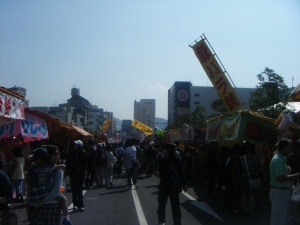 (Later on that same day quite busy)We made our way past the closed stalls, that later on will be teaming with customers trying to buy the food that cooks on open grills, or game stalls where the prize is a tiny turtle or a fish, and even stalls selling j-pop memorabilia or one piece which is huge over there at the minute. We passed members of the festival standing around. Little children in their best kimonos, parade floats and women holding their children as they spoke to their smartly dressed husbands.
(Later on that same day quite busy)We made our way past the closed stalls, that later on will be teaming with customers trying to buy the food that cooks on open grills, or game stalls where the prize is a tiny turtle or a fish, and even stalls selling j-pop memorabilia or one piece which is huge over there at the minute. We passed members of the festival standing around. Little children in their best kimonos, parade floats and women holding their children as they spoke to their smartly dressed husbands.
Our supervisor didn’t seem to know where she was going. She had a piece of paper which were our tickets apparently. The crowd was getting bigger, the amount of people bustling around was phenomenal and the large amount of voices talking in a language that was not English sounded like an annoying, incessant buzzing. We were shown to another part of the stage. Where again our supervisor was told that was not the right place. Finally we were shown to the correct gentlemen who showed us to our seats. Hard back plastic chairs out in the open, no cover and mainly there for the disabled. I was glad that we got the chairs though the only other seating area was tatami which you had to sit on the floor with crossed legs or on your knees which I was in no way able to do.
(That was one side of the other type of sitting) The show opened with the high priests, or that was what they were representing sat in their special places at the front. The show was about to begin. There is a set order to the show and performances and behind every performance there is a story. So let begin.
“Higashi-furukawa-machi is a town that had been lost for 41 years but was re-established in 2007. Twelve children ride in kawafune boat and sixteen people tow the boat. The Kawafune performance of Higashi Furukawa-machi is famous for its funa-uta (sailor’s songs). Halfway through the performance, Nebiki-syu (men who tow a boat) sing five songs, which are said to represent the scenery of Higashi Furukawa-machi.” (English guide.)
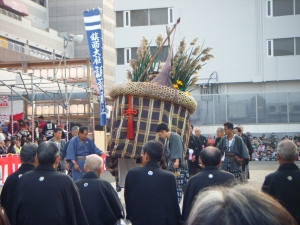 Before every boat scene, there is a short period where a man in a costume, although very intricate and beautiful twirls around whilst four other men, pretty much just watch. When I first saw it, the first one it was beautiful and I liked it. I didn’t really that it would be repeated before every ‘town’ performance although it with different costumes. When the boat came out. The basic gist of the next few performances, which I will not go into detail about again because they were all the same, is pretty much they run up and down, and swing the boat around. That is it.
Before every boat scene, there is a short period where a man in a costume, although very intricate and beautiful twirls around whilst four other men, pretty much just watch. When I first saw it, the first one it was beautiful and I liked it. I didn’t really that it would be repeated before every ‘town’ performance although it with different costumes. When the boat came out. The basic gist of the next few performances, which I will not go into detail about again because they were all the same, is pretty much they run up and down, and swing the boat around. That is it.
It’s interesting but when all of them are doing the same it gets pretty monotonous.
“Daikoku machi was always bustling as a wharf for Chinese ships. The performance of this town is Tojinbune which shows what the town was like in those days. Tojinbune has been performed since 1882. It’s exciting to see 18 men moving a big wooden boat back and forth and rotating it left and right. Daikoku machi’s Hon-odori dance is Ukare Tojin which is about the friendship between the girls of Nagasaki and Tojin (Chinese people).
I liked this performance. Maybe because it was still cool and only about 45 minutes in. The ‘Chinese’ men who pushed the boat were highly energetic and constantly smiling and seemed to have so much life in them. Watching the dance of the Japanese girls and the Chinese woman was mesmerising even if the music scraped through my head other than that I loved it.
Kogawa Machi (小川町)
“Kogawa machi was named after the Iwahara River, commonly called Kogawa which ran through the town.Karakoshishi odori is a combination of the children’s dance in Kogawa machi and the lion’s dance from the Nakao area in Higashi Nagasaki.”
I really liked this performance. It felt that I was not in Japan. The acrobats were amazing and one of the lions was actually two young boys. It was funny and it showed their amazing skill.
“Hon odori dance is the first dance to be performed during Kunchi. Hon odori is the original dance of Kunchi and it is a Japanese dance. Hon odori dance by Kouya machi represents a dyers life because Kouya machi prospered in dye works a long time ago.”
I liked seeing the small dance. It was interesting. It showed talent and you can see partly where the dance form Para Para came from. Whilst it may be a modern dance, the hands are similar. They kept their hands straight in a set position. It was good. However when this performance happened the sun arrived. The heat started to bare down on me. I was sweating and there was no cover. However after every performance they would throw bandanas out to the crowd. Sadly I never got one but the woman in front of me got three!!!! Not fair she could have shared. However like everyone who caught one that was thrown it was instantly placed on their heads in protection from the sun.
“Kokodesyo shaped like a portable shrine with Japanese cushions piled on the top of it, represents a treasure ship sailing across the mighty ocean. It has been 212 years since it first appeared in Kunchi. The highlight of the performance is when the ship is thrown high into the air and caught with the rallying cry Kokodesyo.”
I LOVED THIS PERFORMANCE. I had heard from everyone that this was the best part of the show. They were all true. The rallying cry, the strength in the young men, who the crowd was told were all single “insert wink and crude comment here” and very strong. This performance was loved so much that the usual 20 minute performance extended to 45 minutes.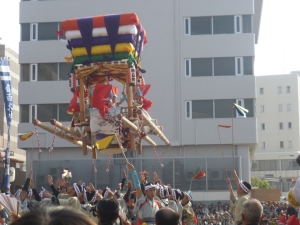

“Motofurukawa machi is said to be the oldest town in the area along the Nakashima River. The boat used to be a battleship, but was changed into Gozabune made of cypress in 1954. The active boat turning is its distinctive feature. The boat weights 2.5 tons”.
This was made all the more interesting, because face it after the first couple of times seeing a float be spun around really fast it gets monotonous, when the commentator stated that the guy in orange, you can see him in the photo, has broken his nose every time he does it. Seeing the bad control they have over the ship compared to the others a strange morbid fascination comes over you. You really want to see him break his nose.
“Dejima is the only place that was allowed to trade with foreign countries during Japan’s isolation. Dejima was associated with Holland because Dutch ships went there. There are 14 children on the Dutch ship.”
To be honest I wasn’t paying much attention. I was hot; I was feeling ill and just wanted a drink of water. We were on the three hour mark when this was shown and although it was magnificent it had started to drag. The crowd constantly called for encore. I constantly called for a drink. Finally though after three and a half hours it was over and I quickly got a drink. I was feeling ill and light headed. Heat stroke had struck and yet I still had to walk around the area, walking past hot stalls and weird panda shaped ghost houses with our supervisor. Having okonomiyaki we then parted ways. She went into you-me-saito mall whilst we went into Starbucks. I instantly having a Frappuccino and a cake to get my sugar levels back up. I get the shakes quite easily.
I soon went home to rest. It was fun and a fascinating insight into the celebratory side of Japanese life. I am happy and thankful I got to go and have such a wonderful seat. I just wished that I had taken a hat.
Sorry for the long post but I hope you liked it.

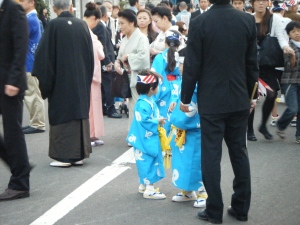
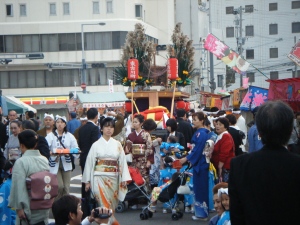

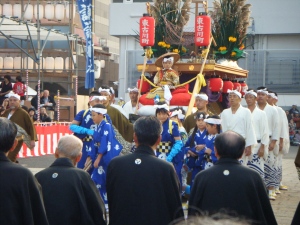


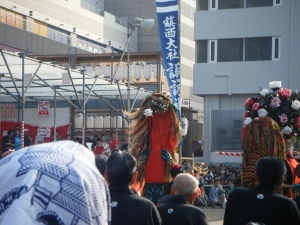
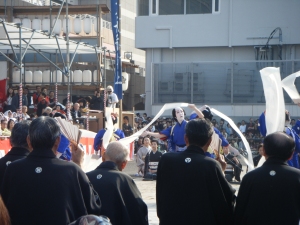


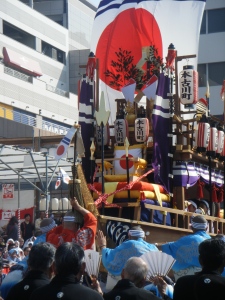
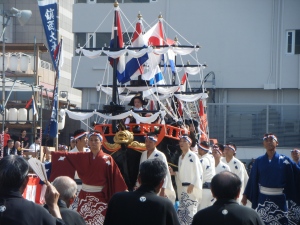
No comments:
Post a Comment